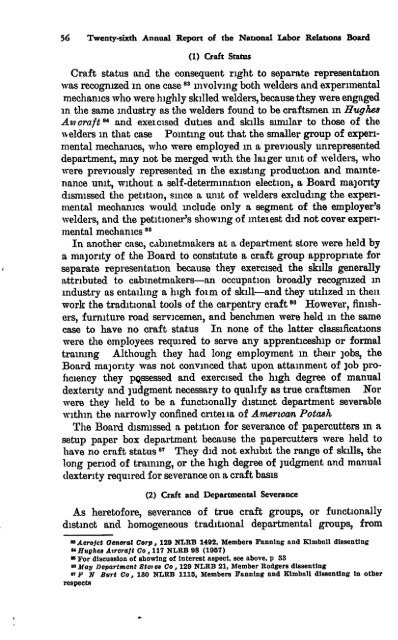TWENTY-SIXTH ANNUAL REPORT - National Labor Relations Board
TWENTY-SIXTH ANNUAL REPORT - National Labor Relations Board
TWENTY-SIXTH ANNUAL REPORT - National Labor Relations Board
You also want an ePaper? Increase the reach of your titles
YUMPU automatically turns print PDFs into web optimized ePapers that Google loves.
56 Twenty-sixth Annual Report of the <strong>National</strong> <strong>Labor</strong> <strong>Relations</strong> <strong>Board</strong><br />
(1) Craft Status<br />
Craft status and the consequent right to separate representation<br />
was recognized in one case 83 involving both welders and experimental<br />
mechanics who were highly skilled welders, because they were engaged<br />
in the same industry as the welders found to be craftsmen in Hughes<br />
Az2 craft 84 and exercised duties and skills similar to those of the<br />
elders in that case Pointing out that the smaller group of experimental<br />
mechanics, who were employed in a previously unrepresented<br />
department, may not be merged with the larger unit of welders, who<br />
were previously represented in the existing production and maintenance<br />
unit, without a self-determination election, a <strong>Board</strong> majority<br />
dismissed the petition, since a unit of welders excluding the experimental<br />
mechanics would include only a segment of the employer's<br />
welders, and the petitioner's showing of interest did not cover experimental<br />
mechanics 85<br />
In another case, cabinetmakers at a department store were held by<br />
a majority of the <strong>Board</strong> to constitute a craft group appropriate for<br />
separate representation because they exercised the skills generally<br />
attributed to cabinetmakers—an occupation broadly recognized in<br />
industry as entailing a high form of skill—and they utilized in their<br />
work the traditional tools of the carpentry craft 85 However, finishers,<br />
furniture road servicemen, and benchmen were held in the same<br />
case to have no craft status In none of the latter classifications<br />
were the employees required to serve any apprenticeship or formal<br />
training Although they had long employment in their jobs, the<br />
<strong>Board</strong> majority was not convinced that upon attainment of job proficiency<br />
they pgssessed and exercised the high degree of manual<br />
dexterity and judgment necessary to qualify as true craftsmen Nor<br />
were they held to be a functionally distinct department severable<br />
within the narrowly confined criteria of American Potash,<br />
The <strong>Board</strong> dismissed a petition for severance of papercutters in a<br />
setup paper box department because the papercutters were held to<br />
have no craft status 87 They did not exhibit the range of skills, the<br />
long period of training, or the high degree of judgment and manual<br />
dexterity required for severance on a craft basis<br />
(2) Craft and Departmental Severance<br />
As heretofore, severance of true craft groups, or functionally<br />
distinct and homogeneous traditional departmental groups, from<br />
Aerofet General Corp, 129 NLRB 1492, Members Panning and Kimball dissenting<br />
" Hughea Aircraft Co, 117 NLRB 98 (1957)<br />
For discussion of showing of interest aspect, see above. P 33<br />
I" May Department Stoics Co • 129 NLRB 21, Member Rodgers dissenting<br />
87 II Burt Co • 130 NLRB 1115, Members Fanning and Kimball dissenting in other<br />
respects

















